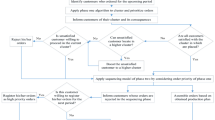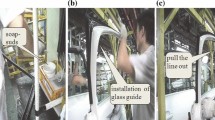Abstract
To solve the sequencing problem in mixed-model flexible assembly lines (MMFALs) with variable launching intervals, a mathematical model aiming to minimize the cost of utility and idle times is developed. To obtain high-quality sequences, an advanced scatter search (ASS) algorithm is proposed. A heuristic approach, i.e. launching intervals between products algorithm (LIBPA), is incorporated into the ASS algorithm to solve the launching interval problem for each sequence. Numerical experiments with different scales are conducted to compare the performance of ASS with genetic algorithm (GA). In addition, we compare the cost of variable launching intervals approach with fixed launching intervals approach. The results indicate that the ASS is efficient and effective, and considering variable launching intervals in mixed-model assembly lines (MMALs) sequencing problem can improve the performance of the line.
Similar content being viewed by others
Abbreviations
- a i+1 :
-
Launching interval between product i and i + 1 in a sequence
- C Idl :
-
Unit cost of idle
- C U :
-
Unit cost of utility
- d m :
-
Minimum part-set demand for model m
- i :
-
Indices for products, i = 1, 2, …, I
- I :
-
Total number of products to be sequenced
- j :
-
Indices for stations, j = 1, 2, …, J
- J :
-
Number of stations
- L j :
-
Length of station j
- L MD j :
-
Maximum length that is allowed to exceed the downstream boundary of station j
- L MU j :
-
Maximum length that is allowed to exceed the upstream boundary of station j
- L IDF :
-
Distance associated with first type of idle time
- L IDS :
-
Distance associated with second type of idle time
- L UW :
-
Distance associated with utility work
- m :
-
Indices for models, m = 1, 2, …,M
- M :
-
Number of models
- P :
-
A large set of diverse solutions
- R j :
-
Zero reference point of station j
- t mj :
-
Assembly time for model m at station j
- t ID ij :
-
Total idle time at station j for product i
- t w ij :
-
Utility worker time on product i at station j
- v c :
-
Downstream speed of the conveyor
- x im :
-
1 if product i in a sequence is model m, 0 otherwise
- Z f ij :
-
Finishing position of the work on product i in a sequence at station j
- Z s ij :
-
Starting position of the work on product i in a sequence at station j
References
Prombanpong S, Dumkum C, Satranonda E. A fixed rate launching of mixed-model car sequencing in the multiple assembly lines [C]//International Conference on Industrial Engineering and Engineering Management. [s.l.]: IEEE, 2010: 1266–1270.
Bock S, Rosenberg O, van Brackel T. Controlling mixed-model assembly lines in real-time by using distributed systems [J]. European Journal of Operational Research, 2006, 168(3): 880–894.
Sarker B R, Pan H. Design configuration for a closed-station, mixed-model assembly line: A filing cabinet manufacturing system [J]. International Journal of Production Research, 2001, 39(10): 2251–2270.
Fattahi P, Salehi M. Sequencing the mixed-model assembly line to minimize the total utility and idle costs with variable launching interval [J]. International Journal of Advanced Manufacturing Technology, 2009, 45(9–10): 987–998.
Liu R, Lou P H, Tang D B, et al. A hybrid immune algorithm for sequencing the mixedmodel assembly line with variable launching intervals [C]//Information Computing and Applications-International Conference. Berlin: Springer-Verlag, 2010: 399–406.
Boysen N, Fliedner M, Scholl A. Sequencing mixed-model assembly lines: Survey, classification and model critique [J]. European Journal of Operational Research, 2009, 192(2): 349–373.
Sarker B R, Pan H. Designing a mixed-model assembly line to minimize the costs of idle and utility times [J]. Computers & Industrial Engineering, 1998, 34(3): 609–628.
Kim Y K, Hyun C J, Kim Y. Sequencing in mixed model assembly lines: A genetic algorithm approach [J]. Computers & Operations Research, 1996, 23(12): 1131–1145.
Belfiore P, Yoshizakih H T Y. Scatter search for a real life heterogeneous fleet vehicle routing problem with time windows and split deliveries in Brazil [J]. European Journal of Operational Research, 2009, 199(3): 750–758.
Rahimi-Vahed A R, Rabbani M, Tavakkoli-Moghaddam R, et al. A multi-objective scatter search for a mixed-model assembly line sequencing problem [J]. Advanced Engineering Informatics, 2007, 21(1): 85–99.
Cano-Belmán J, Ríos-Mercado R Z, Bautista J. A scatter search based hyper-heuristic for sequencing a mixed-model assembly line [J]. Journal of Heuristics, 2010, 16(6): 749–770.
Liu Qiong, Wang Wen-xi, Zhang Chao-yong, et al. Advanced scatter search approach for sequencing problems in mixed model assembly lines [J]. Computer Integrated Manufacturing Systems, 2011, 17(4): 776–782 (in Chinese).
Author information
Authors and Affiliations
Corresponding author
Additional information
Foundation item: the National Natural Science Foundation of China (No. 71071115) and the National High Technology Research and Development Program (863) of China (No. 2009AA043000)
Rights and permissions
About this article
Cite this article
Tong, Kn., Xu, Kl. & Zheng, Yq. Sequencing mixed-model flexible assembly lines with variable launching intervals. J. Shanghai Jiaotong Univ. (Sci.) 18, 460–467 (2013). https://doi.org/10.1007/s12204-013-1420-3
Received:
Published:
Issue Date:
DOI: https://doi.org/10.1007/s12204-013-1420-3
Key words
- variable launching intervals
- mixed-model assembly line (MMAL)
- flexible
- sequencing
- scatter search algorithm




